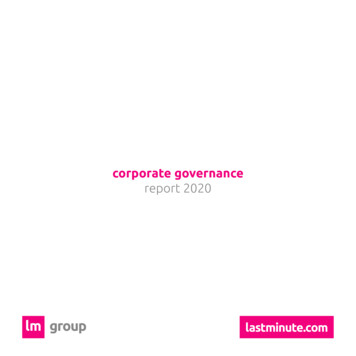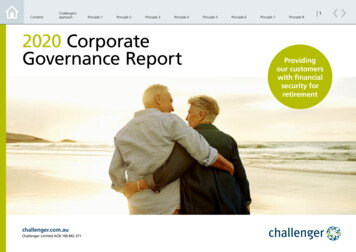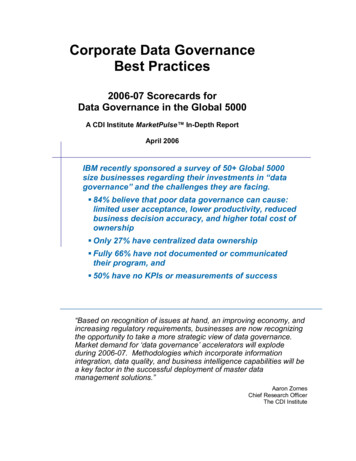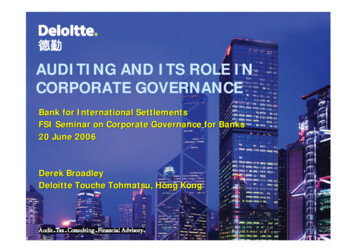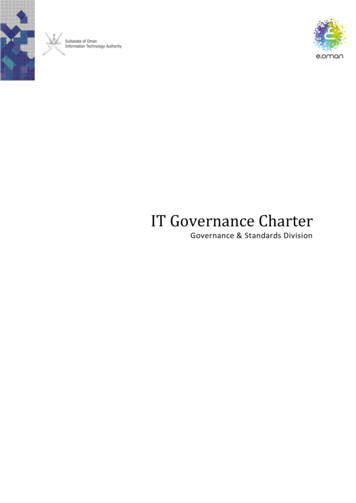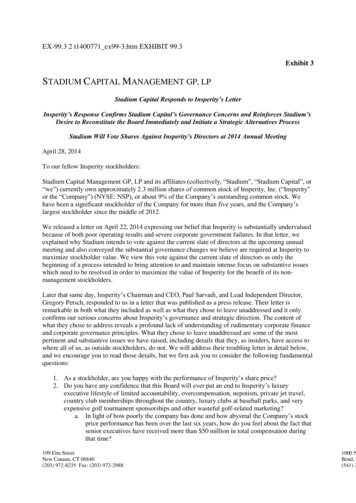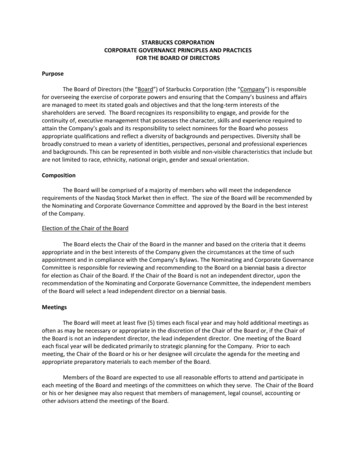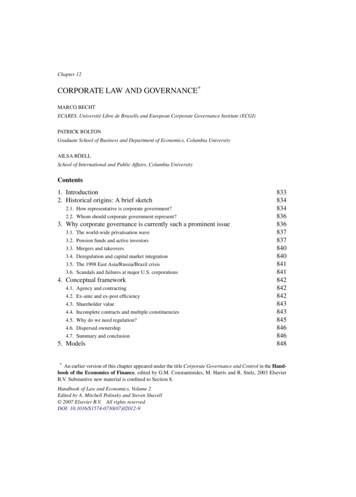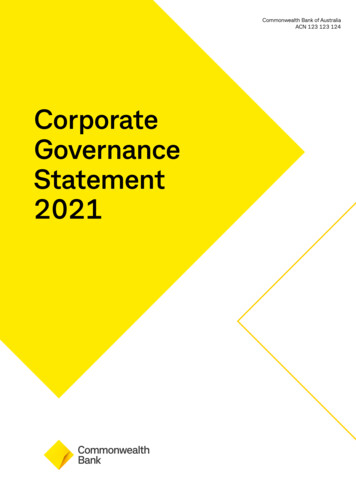
Transcription
Commonwealth Bank of AustraliaACN 123 123 124CorporateGovernanceStatement2021
Corporate Governance Statement 2021The Commonwealth Bank of Australia is committed to our strategy to build tomorrow’s banktoday for our customers and to fulfil our purpose of improving the financial wellbeing of ourcustomers and communities. Effective governance is key to the Bank’s ability to deliver onour purpose and strategy.The Commonwealth Bank of Australia (CBA or Bank) is committed to continuously improving our governance practices andensuring that they are aligned with our business and stakeholders’ needs. The Board’s role is to represent shareholders bysetting the Bank’s strategic direction and instilling a culture that is reflective, risk aware and accountable to achieve stakeholderoutcomes that are fair and balanced.This Statement describes the key governance arrangements and practices of the Bank and its related bodies corporate(Group). CBA has followed the fourth edition of the ASX Corporate Governance Council’s Corporate Governance Principlesand Recommendations (ASX 4th Edition) for the reporting period ending 30 June 2021. The Group must comply with theCorporations Act 2001 (Cth) (Corporations Act) and the Banking Act 1959 (Cth) including Part IIAA of the Banking ExecutiveAccountability Regime (BEAR) amongst other laws, and, as an authorised deposit-taking institution, with governancerequirements prescribed by the Australian Prudential Regulation Authority (APRA) under Prudential Standard CPS 510Governance. The Group’s main business activities are also subject to industry codes of practice, such as the Australian BankingAssociation Banking Code of Practice.The Board regularly reviews and refines its corporate governance arrangements and practices in light of new laws and regulations,evolving stakeholder expectations and the dynamic environment in which the Group operates.This Statement has been approved by the Board and is current as at 11 August 2021.Board of DirectorsCatherine Livingstone AOMatt ComynShirish ApteGenevieve Bell AOChairmanManaging Director andChief Executive OfficerIndependent Non-ExecutiveDirectorIndependent Non-ExecutiveDirectorPeter HarmerPaul O’MalleySimon MoutterMary PadburyIndependent Non-ExecutiveDirectorIndependent Non-ExecutiveDirectorIndependent Non-ExecutiveDirectorIndependent Non-ExecutiveDirectorAnne Templeman-JonesRob Whitfield AMIndependent Non-ExecutiveDirectorIndependent Non-ExecutiveDirectorFull biographies are available on our website at commbank.com.au/about-us/our-company.Commonwealth Bank2
Corporate Governance Statement 2021Governance FrameworkStakeholdersIndependentassurance and adviceAuditCommitteeRisk &ComplianceCommitteeNominationsCommitteePeople &RemunerationCommitteeIncluding internal andexternal auditCEOExecutive Leadership TeamPurpose, values and cultureStrategy and risk managementCBA BoardOur peoplePolicies, systems and processesKeyDelegationAccountabilityThe Bank’s Governance Framework is based on accountability, effective delegation and adequate oversight to supportsound decision-making.The Board is responsible for setting the strategic objectives and risk appetite of the Bank, and approves the Group’s Codeof Conduct to set the Board’s expectations for the Group’s values and desired culture.The Board delegates certain powers to Board Committees to help it fulfil its roles and responsibilities. The Board also appointsthe Chief Executive Officer (CEO). The Board has delegated the management of the Bank to the CEO, except for thosematters specifically reserved to the Board or its Committees. The CEO, in turn, may, and has, delegated some of these powersto Group Executives and other officers under instruments of delegation. Regardless of any delegations by the CEO, the CEOis accountable to the Board for the exercise of the delegated powers and management’s performance.At its discretion, the Board may form other committees to undertake specific duties from time to time.The key functions of the Board and its Board Committees are outlined in this Statement. Copies of the Board and BoardCommittee Charters can be found on our website at commbank.com.au/corporategovernance.Commonwealth Bank3
Corporate Governance Statement 2021CultureThe Bank remains focused on shaping a culture that supports the achievement of business strategies, including sustaining ourfocus on risk culture to enable better outcomes for our customers and stakeholders. The Board acknowledges that communityconfidence and trust in the Bank continues to depend on this, and this has been particularly apparent during the Bank’s responseto the COVID-19 pandemic.The Board recognises that, together with management, it has a critical role in setting the cultural tone of the Bank, and it guidesthe Bank’s culture through the CEO. Our culture, anchored in our values of Care, Courage and Commitment, is instilled andreinforced by the Executive Leadership Team.The Board monitors culture and cultural change initiatives by leveraging data and insights provided from a range of resourcesincluding employee culture and engagement surveys, strategic metrics and focus groups, as well as audit reports, compliancereports and whistleblower reports.Our Purpose and ValuesThe Bank’s purpose is to improve the financial wellbeing of our customers and communities.We are guided by our values of Care, Courage and Commitment:We care about our customers andeach other – we serve with humilityand transparencyWe have the courage to step in,speak up and lead by exampleWe are unwavering in our commitment– we do what’s right and we worktogether to get things doneOur purpose and values are reinforced across the Bank through various communication channels, policies, processes andlearning and development initiatives. Conduct is formally assessed with respect to the Bank’s values, risk and key performanceindicators during employee performance reviews.During the 2021 financial year, other mechanisms to reinforce the Bank’s purpose and values included: a continued focus on senior leader role-modelling and authentic communication to send consistent cultural cues through tone,language and behaviour; a focus on unifying, empowering, developing and connecting leaders across the Bank through an ongoing series of quarterlyand bi-annual leader forums; providing broader context on the Bank’s strategy and operations through the CEO’s fortnightly CommBank Live online interviewsession available to all employees; performing a comprehensive assessment of our organisational culture (including risk culture) to ensure continued alignmentto the strategy and our values; launching and embedding our values through regular targeted employee communications; and amplifying values stories and examples through employee recognition programs, both through our everyday Legends Programand through quarterly and annual Excellence Awards.Commonwealth Bank4
Corporate Governance Statement 2021PoliciesPolicies play a vital role in guiding decision-making and conduct across the Group. The Bank remains focused on enhancingthe Group’s policy framework to ensure our policies and supporting procedures are fit for purpose.Code of ConductThe Group’s Code of Conduct (Code) sets the standards of behaviour, actions and decisions expected of our people (includingthe Board) when engaging with, and balancing the interests of, the Bank’s stakeholders. The Code connects our purpose andvalues with a ‘Should We?’ test, to help deliver the outcomes we expect. It guides our decision-making, sets clear boundaries,and provides a roadmap for getting help when we run into challenges. Material breaches of the Code are reported to the AuditCommittee. The Code is available on our website at commbank.com.au/policies.Whistleblower ProtectionThe Group is committed to fostering a culture where our people and others feel safe to speak up on matters or conduct thatconcerns them. The Group Whistleblower Policy provides clarity on how the Group will support and protect our people andothers to express their concerns, as well as the manner in which concerns can be raised and will be managed.The Group has: a Whistleblower Protection Officer whose role includes overseeing the protection of whistleblowers, including their wellbeing; SpeakUP services (including online and independently provided telephone and email services) that provide avenues forindividuals to raise concerns, including anonymously; and a Misconduct Governance Committee that oversees the effectiveness of the whistleblower program.The Audit Committee is provided with regular reporting on the operation of the whistleblower program, including materialmatters reported under the Group Whistleblower Policy. The reporting takes into account legislative constraints surrounding bothwhistleblower protection and confidentiality.The Group Whistleblower Policy is available on our website at commbank.com.au/policies.Anti-Bribery and CorruptionThe Group is committed to embedding a zero appetite culture for bribery, corruption and facilitation payments. An Anti-Bribery& Corruption (AB&C) framework, comprising a Group AB&C Policy and Standard, has been created to: formally acknowledge the serious nature of bribery and corruption; prohibit the giving, receiving or offering of bribes, facilitation payments or other improper benefits to/from another person,including public officials; identify potential risks and appropriate controls relating to key bribery and corruption risk areas such as the offering oraccepting of gifts and entertainment; sponsorships & donations; hiring opportunities as well as the engagement of thirdparty service providers who may act for, or on behalf of, the Group; require all parts of the Group to identify and understand the bribery and corruption risks relevant to their operations,and implement appropriate controls; and outline the requirements for escalating and reporting Group AB&C Policy breaches.Material breaches of the policy must be reported to the Risk & Compliance Committee and will be reported to theAudit Committee if the matter is raised under the SpeakUP Program. The Group AB&C Policy is available on our websiteat commbank.com.au/policies.Inclusion and DiversityThe Group Inclusion and Diversity Policy outlines our approach and commitment to inclusion and diversity. The policy statesthe principles our employees and senior leaders are expected to work towards to deliver a workplace that is safe, accessibleand inclusive, where everyone feels valued and respected.Under the policy, and in accordance with the Board Charter, the Board is responsible for approving the Group’s Inclusion andDiversity Policy, and setting, and annually assessing, measurable objectives in relation to diversity and progress against achievingthem (in conjunction with the Nominations and People & Remuneration Committees). Further details about these objectives areset out on page 10 of this Statement and pages 39 and 63 of the 2021 Annual Report.The Group Inclusion and Diversity Policy is available on our website at commbank.com.au/policies.Commonwealth Bank5
Corporate Governance Statement 2021Conflicts ManagementThe Group Conflicts Management Policy is designed to ensure that actual, perceived or potential conflicts of interest areidentified, managed or prevented. The policy outlines the organisational and administrative arrangements in place to supportthe identification and management of conflicts of interest.Fit and ProperThe Group Fit and Proper Policy addresses the requirements of APRA’s Prudential Standards CPS 520 Fit and Proper and SPS520 Fit and Proper. The policy requires all persons appointed to a Responsible Person role (including CBA Directors) to satisfythe fit and proper requirements prior to their initial appointment, and be re-assessed annually, or at any time information thatmay affect their fit and proper status becomes known.Securities TradingThe Group Securities Trading Policy sets out when our people and their associates may deal in securities, including Group securities.The policy prohibits dealing in securities when in possession of inside information. It also prohibits certain specified personsand their associates from dealing in Group securities except during limited ‘trading windows’.The policy also sets out the Bank’s prohibition on hedging or otherwise limiting economic exposure to equity price riskin relation to unvested equity-linked remuneration issued under any Group equity arrangement.The Group Securities Trading Policy is available on our website at commbank.com.au/corporategovernance.Environmental and Social PolicyThe Group’s Environmental and Social Policy details our commitment to managing environmental and social risks, includingclimate change, human rights and modern slavery. During the 2021 financial year, the Group published its first Modern SlaveryStatement in compliance with Australia’s Modern Slavery Act 2018 (Cth) and the UK Modern Slavery Act. The Statement disclosedthe actions taken during the 2020 financial year to identify and mitigate modern slavery and human trafficking in our businessoperations, lending and supply chain.The Group regularly assesses and discloses our climate-related progress, performance and the Group’s plans in line with therecommendations of the Task Force on Climate-related Financial Disclosures (TCFD).Our reports are available on our website at commbank.com.au/CRreporting.Entity GovernanceThe Board has adopted a suite of entity governance policies and associated documents which includes the following:1. Group Subsidiary Governance Framework, which outlines the corporate governance practices and principles that applyto Group Subsidiaries including director and officer responsibilities, and board governance and information flow;2. Group Board Appointment, Renewal and Performance Policy, which sets out the standard for the appointment, renewal,evaluation, performance and removal of Directors to the Board and other boards within the Group;3. Entity Lifecycle Framework, which outlines the corporate governance, legal and regulatory requirements that applyto the formation, ongoing maintenance and de-registration of subsidiaries;4. Group Policy Framework Policy, which sets out the requirements for the development and maintenance of policies,standards and procedures across the Group, to ensure these documents are clear, consistent, fit for purpose,operationalised and well governed; and5. Minority Investment Entities Framework, which sets out the approach for the management and governanceof Minority Investment Entities (entities in which the Group has a minority, non-controlling interest).Commonwealth Bank6
Corporate Governance Statement 2021Risk Management and AssuranceThe Group monitors and manages its exposure to financial, non-financial and strategic risks, and is committed to having riskmanagement policies, processes and practices that support a high standard of risk governance whilst enabling managementto undertake prudent risk-taking activities.Risk Management FrameworkThe Group’s Risk Management function designs and oversees the Group Risk Management Framework for managing theGroup’s material risk types.The Group Risk Management Framework covers the systems, structures, policies, processes and people that identify, measure,evaluate, monitor, report and control or mitigate both internal and external sources of material risk. It incorporates three keydocuments: Group Risk Appetite Statement (RAS), which articulates the type and degree of risk the Board is prepared to accept,and the maximum level of risk that the Group must operate within; Group Risk Management Approach (RMA), which describes the Group’s approach to ensuring comprehensive management of itsrisks in support of achieving its strategic goals and objectives; and Group Strategy, which articulates the Group’s approach to implementing its strategic objectives through the Business Plan.The Board is ultimately responsible for the Group Risk Management Framework and for overseeing its operation by management.As required under APRA’s Prudential Standard CPS 220 Risk Management, the Board: approves the Group RAS and the Group RMA, and ensures consistency of developed policies and processes; ensures that the Group Risk Management Framework is subject to external review every three years; receives regular management reporting to monitor that material risks are managed within approved appetite; forms a view on the risk culture of the Group and oversees relevant improvement action plans; and makes an annual Risk Management Declaration (RMD) to APRA that is signed by the Chairs of the Board and the Risk &Compliance Committee on the adequacy of design and operating effectiveness of the Group Risk Management Framework.As part of its consideration of the RMD, the Board regularly makes appropriate enquiries to satisfy itself that in all materialrespects the Group Risk Management Framework is appropriate to the Group. The most recent RMD was provided to APRAin October 2020. For more information, refer to pages 42 to 47 of the 2021 Annual Report.Remedial Action PlanFollowing publication of the APRA Prudential Inquiry (PI) Report in May 2018, the Bank committed to implementall recommendations. Addressing the findings of the Inquiry Report is a key focus of the Board and management.The Bank has a Remedial Action Plan (RAP) in place to address the recommendations outlined in the PI Report. The RAPwas approved by APRA on 29 June 2018 and includes a focus on strengthening the Risk Management Framework, particularlyin respect of operational risk and compliance risk management.Examples of progress under the RAP include: there is now clear and committed leadership from the top in managing non-financial risk; accountabilities for management have been clarified and documented; there is much clearer and stronger focus on ensuring good customer outcomes, and the ‘Should We?’ question has becomean integral part of the Group’s everyday conversations; and constructive challenge is not only a consistent feature of meetings and forums, it is welcomed.All recommendations from the PI Report have now been delivered to the RAP Independent Reviewer, Promontory, by thescheduled due dates. The Group has fully embraced the PI recommendations and will continue to embed the changes as partof how we operate.For more on the Bank’s response to the PI Report, refer to pages 18, 19, 45 and 69 of the 2021 Annual Report, and our websiteat commbank.com.au/APRA.Exposure to Environmental and Social RiskThe Bank has implemented policy frameworks for considering Environmental and Social (E&S) risks, including climate change.These risks could adversely affect the Group and the achievement of its objectives. More information about the Group’s materialE&S risks and how the Group seeks to manage them is described on pages 22 to 33 and 44 to 47 of the 2021 Annual Report.The Group’s approach to climate change (including strategy, risk management, metrics and targets) is in line with theTCFD recommendations. For more information, refer to pages 22 to 33 of the 2021 Annual Report.Commonwealth Bank7
Corporate Governance Statement 2021Internal AuditGroup Audit & Assurance (GA&A) is the Internal Audit function of the Group, also called the 3rd Line of Accountability(3LoA or Line 3). Its role is to provide independent and objective assurance and related consulting services to management,as well as the Audit, Nominations, Risk & Compliance, and People & Remuneration Committees.GA&A is structured to be independent of management, with the most senior GA&A executive, the Group Auditor, reportingdirectly to the Audit Committee Chair. The Audit Committee holds regular discussions with the Group Auditor in the absenceof management. The Group Auditor may only be appointed or dismissed with the Audit Committee’s approval. The Group Auditorhas free and unrestricted access to all of the Group’s information, people, property and records to discharge GA&A’s role. In majoroffshore subsidiary entities, local audit teams operate similarly, but with a direct reporting line to local board committees.GA&A operates under a separate Charter approved by the Audit Committee, conducts its activities in line with localaccounting and regulatory standards and adheres to the Institute of Internal Auditors’ International Professional PracticeFramework, including the Core Principles for the Professional Practice of Internal Auditing and the Definition of Internal Auditing.GA&A is also subject to external review every three years.GA&A’s responsibilities include: developing a risk-based annual Group internal audit plan for the Audit Committee’s approval and adjusting that plan wherenecessary to reflect current and emerging risks; executing the audit plan in line with approved audit methodologies and reporting the results of its work to management,the Audit Committee and, where appropriate, to the Risk & Compliance Committee; and escalating to management, and the Audit Committee or Risk & Compliance Committee, as appropriate, instances where GA&Abelieves that management has accepted a level of risk in excess of the business area’s approved risk appetite. The Group Auditoralso monitors and reports on progress in addressing significant control and risk issues.External AuditorPricewaterhouseCoopers (PwC) was appointed as the Group’s External Auditor (External Auditor) at the 2007 Annual GeneralMeeting (AGM). The External Auditor provides an independent opinion on whether, among other things, the Group’s financialreport provides a true and fair view of the Group’s financial position and performance.In line with legislation promoting auditor independence, the Group requires rotation of PwC’s lead audit partner after the auditof five successive financial years. The current lead audit partner, Matthew Lunn, was appointed effective from 1 July 2017.The lead audit partner holds regular discussions with the Audit Committee without management present. The External Auditorattends the AGM and is available to respond to shareholder questions on any matter that concerns them in their capacity asauditor. The Group and its External Auditor must comply with Australian and United States auditor independence requirements.United States Securities and Exchange Commission rules apply to various activities the Group undertakes in the United States,even though the Bank is not registered under its Exchange Act. A statement of the Board’s satisfaction that the non-auditservices provided by PwC did not compromise the auditor independence requirements is provided in the Directors’ Report,within the 2021 Annual Report.CEO and CFO DeclarationsBefore the Board approved the Group’s half-year and full-year financial statements for 2021, the CEO and CFO providedthe Board with written declarations that, in their opinion: the Group’s financial records have been properly maintained in accordance with the Corporations Act; the financial statements and notes comply with the accounting standards and give a true and fair view of the Group’sfinancial position and performance; and the declarations are formed on the basis of a sound system of risk management and internal control, which is operating effectively.Commonwealth Bank8
Corporate Governance Statement 2021StakeholdersThe Bank works closely and constructively with our wide range of stakeholders which allows us to understand the issues thatmatter most to them. We build partnerships and seek the views of various groups through forums such as our CEO AdvisoryPanel, Community Council and Indigenous Advisory Council. We also work collaboratively with government representatives andindustry groups, for example the Australian Sustainable Finance Initiative (ASFI), Climate Leadership Coalition (CLC) and theAustralian Banking Association (ABA) to consider societal issues and drive systemic change.CustomersThe Bank has a dedicated Customer and Community Advocacy team. This team represents the voice of the customerand community within the Bank to enhance and protect customer outcomes. They do this by: removing barriers to banking that stand in the way of financial inclusion; finding and fixing issues that could have a negative impact on customers, including by identifying and eliminating systemicissues/themes; providing a helping hand to customers in vulnerable circumstances and being an escalation point for frontline staff; building a better bank by improving customer advocacy in decision-making; and restoring relationships between our people, our customers and our community, particularly through complaint resolution.The Bank also engages with our customers through customer feedback, surveys and workshops, customer representativebodies, complaint channels and external dispute resolution bodies.CommunityTo deliver sustainable outcomes and financial wellbeing for our stakeholders, first we must understand the expectations of thecommunities in which we operate.We engage with members of the community through a variety of channels and use the insights we gain to improve our productsand service. This in turn allows us to deliver better outcomes for our customers.During the 2021 financial year, the Bank made cash contributions of 47.3 million into the community. We give our people theopportunity to support community organisations that matter to them. Through the CommBank Staff Foundation, one of Australia’slargest workplace giving programs, we donated more than 2.5 million to eligible community organisations including The HumourFoundation, Thread Together and Wayside Chapel, and raised more than 3 million for cancer research during the financial year.Our PeopleThe People & Remuneration Committee assists the Board to discharge its responsibilities on matters relating to organisationalculture, inclusion and diversity, and the health, safety and wellbeing of our people.A copy of the Charter is available on our website at commbank.com.au/corporategovernance.The Bank is committed to: building an inclusive and diverse culture; supporting flexible work practices; providing our people, regardless of their gender, age, sexual orientation, ethnicity or other identities, characteristics orexperiences, with access to paid leave and other support to assist them with caring and family responsibilities; and rewarding our people appropriately.Building an Inclusive and Diverse CultureWe are committed to fostering an inclusive culture that embraces the diversity of our people and is grounded on the foundationsof equality, care and respect, so that our people can be themselves, feel that they belong, and thrive. An inclusive culture anddiverse workforce helps us to fulfil our purpose of improving the financial wellbeing of our customers and communities. In January2021, we launched our new Inclusion and Diversity strategy, which was endorsed by the Board and is available on our website atcommbank.com.au/diversity.Our operating environment is constantly shifting, with external and internal factors affecting the experience of our people andimpacting our workplace. Our Inclusion and Diversity strategy is built on actions taken to learn from the experiences of our people,our customers, and the community. This includes listening sessions to understand the employee and customer experience,embedding fair and equitable people related processes, and regularly measuring ourselves and reporting against our objectives.While results demonstrate that the Bank is well positioned to understand and respond to the needs of our customers andcommunities, we know there’s more work to be done to improve the diversity of our leadership teams.Commonwealth Bank9
Corporate Governance Statement 2021Gender DiversityThe Nominations Committee assists the Board with setting and approving measurable objectives for gender diversity in thecomposition of the Board and the boards of nominated subsidiaries. The People & Remuneration Committee assists the Boardwith setting measurable objectives for gender diversity applicable to the workforce more broadly, including senior executives.The current measurable objective for the composition of the Board is to maintain at least 40% female representation. As at30 June 2021, women represented 40% of the Board.With regard to the composition of the Bank’s workforce generally, given that for a number of years the majority of our workforcehas been made up of women, and as at 30 June 2021 women represented 56.1% of our workforce, we have focused on settingmeasurable objectives to increase the representation of women in our leadership roles. We continue to regularly monitor andreport annually on the proportion of women in our workforce generally to ensure we maintain gender diversity. We expect ourPeople Leaders to build diverse teams and this is reflected in their (Board approved) Key Performance Indicators to drive positiveaction towards our gender equality goals. Quarterly inclusion conversations are one of the ways in which our General Managersand above regularly review gender diversity for their teams and identify actions for improvement. To inform these conversationswe equip them with data insights including the gender ratios at each role level and the gender breakdown of new hires anddepartures from the Group. The Group’s Inclusion Forum, which includes two Group Executives and other senior executivesof the Bank, monitors the Group’s progress towards achieving our gender equality goals, informs the development of inclusionconversations and discusses outcomes from those conversations.We participate in the Bloomberg Gender-Equality Index as our primary benchmark for tracking our progress in advancing genderequality for our people, our customers, and the community. This year, we were one of 380 companies worldwide to be includedin the 2021 Bloomberg Gender-Equality Index.The measurable objectiv
This Statement describes the key governance arrangements and practices of the Bank and its related bodies corporate (Group). CBA has followed the fourth edition of the ASX Corporate Governance Council’s Corporate Governance Principles and Recommendations (ASX 4th Edition) for the report
